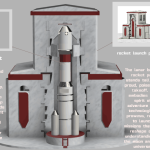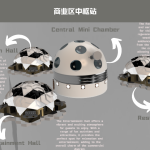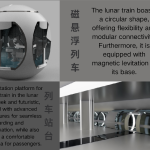MARS BASE by Laika
IES CERVANTES MADRID-MADRID Spain 6 years old and younger 4 / 4 English Mars
External link for Tinkercad 3D design
Project description
We decided to build a base in Mars because it is more similar to the Earth and we can obtain water and energy easier. We will obtain the oxygen thanks to the water ice in mars. Our base will be done in a base of mars, our base on mars is established on a rocky surface, it consists of four domes, one large and three small, being made of glass it has a greenhouse effect and this will help to protect us from the heat and cold, as temperatures are unstable. there is also a vegetable garden with fruits and vegetables that will serve as food. Our material and home-survival ideas for construction of the base are the following: first rigolith, which contains various minerals, including basalt, which could be melted and used as a binding agent for construction. Then 3D printing technology, that could be employed to construct the habitat using rigolith, and this process involves layering the material to create the desired structure. In the third option we have greenhouse for oxygen production; hydroponics or aeroponics systems could be employed for growing plants. Other important thing is radiation protection because of mars’s high levels of radiations. Constructing layers of regolith can help mitigate radiation exposure. Solar panels can be used to generate electricity, including energy storage systems, such as batteries, to store excess energy for use during the Martian night. Also ensuring airtight seals is crucial to maintain a habitable environment, and seals must withstand the temperature variations and atmospheric conditions on Mars.
Although there are rovers already done in Mars, we know how to make one with materials in the Red Planet. It is possible to build a rover using materials present on Mars, such as regolith, basaltic rock, iron oxides, water ice, sulfur, silica, and magnesium. However, the specific properties of each material must be considered, and the rover design should take into account the unique conditions of the Martian environment. Precautions should be taken to protect mechanical and electronic systems from surface dust, and materials resistant to corrosion in the presence of sulfur should be selected. Collaboration with experts in engineering and planetary science would be essential for the success of the project.
An important thing is, how can we feed ourselves? Controlled greenhouses could be established to protect plants from radiation. As we said before, hydroponic or aeroponic systems could be used to grow food without the need for soil, potentially using nutrient-enriched soil. Consider the possibility of insect farming as a sustainable source of protein. Insects may be efficient at converting organic matter into protein and could be raised in controlled environments.
Another very important question is, how can we breathe in Mars? To breathe on Mars, life support systems would be needed, such as space suits with oxygen supply, and habitats with oxygen production and storage systems. Currently, there is no breathable air on Mars, and exploration and colonization would require advanced technologies to generate a habitable atmosphere.
#3D Design
Other Projects
Puente San Miguel – Spain
Moonopolis: Lunar Haven-模拟月球基地建设与人文关怀






























